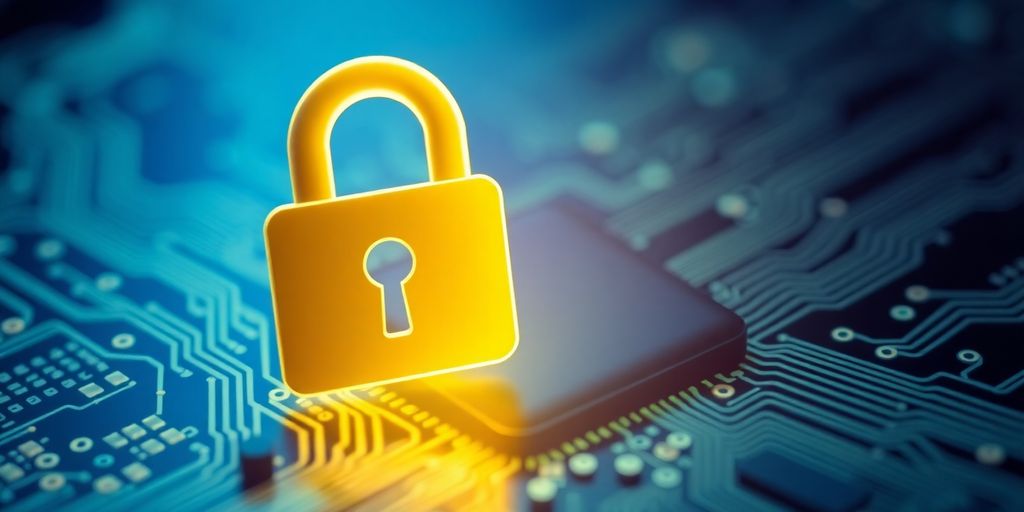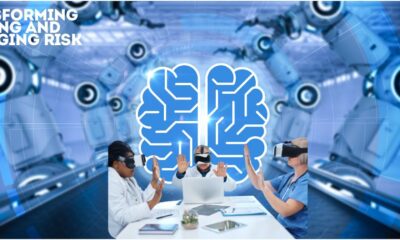Cybersecurity
AI Cybersecurity Solutions: Securing the Future

Artificial Intelligence (AI) is changing the way we think about cybersecurity. As technology evolves, so do the threats we face. AI offers innovative solutions to protect our information and systems from cyber attacks. In this article, we will explore how AI can enhance cybersecurity, the challenges it brings, and the future of this technology in keeping us safe.
Key Takeaways
- AI helps detect threats faster than humans can.
- Using AI can automate responses to cyber incidents.
- AI improves how we protect sensitive data.
- AI is essential for modern security operations.
- Adopting AI in cybersecurity requires careful planning.
Understanding AI Cybersecurity Solutions
Defining AI in Cybersecurity
Artificial Intelligence (AI) in cybersecurity refers to the use of advanced algorithms and machine learning techniques to enhance security measures. AI helps in identifying threats, automating responses, and managing risks effectively. AI revolutionises cybersecurity by providing tools that can learn from data and improve over time.
Historical Context and Evolution
The journey of AI in cybersecurity began with simple algorithms that could detect known threats. Over time, these systems have evolved into sophisticated models capable of predicting and responding to new threats. Key milestones include:
- The introduction of machine learning in threat detection
- Development of automated incident response systems
- Integration of AI with existing security frameworks
Key Components of AI Cybersecurity
AI cybersecurity solutions consist of several essential components:
- Data Analysis: AI systems analyse vast amounts of data to identify patterns and anomalies.
- Threat Intelligence: AI gathers and processes information about potential threats from various sources.
- Automated Responses: AI can automatically respond to detected threats, reducing the time taken to mitigate risks.
In the rapidly changing landscape of cyber threats, AI is not just an option; it is becoming a necessity for effective defence.
| Component | Description |
|---|---|
| Data Analysis | Identifies patterns in large datasets |
| Threat Intelligence | Gathers information on potential threats |
| Automated Responses | Responds to threats without human intervention |
By understanding these components, organisations can better implement AI solutions to enhance their cybersecurity posture.
The Role of AI in Modern Cybersecurity
AI-Powered Threat Detection
AI is transforming how we detect threats in cybersecurity. AI systems can analyse vast amounts of data quickly, identifying patterns that humans might miss. This capability allows for:
- Faster detection of potential threats
- Improved accuracy in identifying false positives
- Continuous monitoring of systems for unusual activities
Automating Incident Response
AI not only detects threats but also helps in responding to them. By automating incident response, organisations can:
- Reduce the time taken to respond to incidents
- Minimise human error during critical situations
- Ensure consistent application of security protocols
Enhancing Data Protection with AI
AI enhances data protection by:
- Monitoring access to sensitive information
- Identifying and mitigating risks in real-time
- Implementing advanced encryption techniques to secure data
In a world where cyber threats are constantly evolving, integrating AI into cybersecurity is not just beneficial; it is essential for maintaining a secure environment.
AI’s role in modern cybersecurity is crucial, as it helps organisations stay ahead of increasingly sophisticated attacks. By leveraging AI, businesses can create a more resilient security posture, ensuring that they are prepared for the challenges of the future.
AI-driven solutions are becoming the backbone of effective cybersecurity strategies.
AI in Security Operations Centres (SOCs)
Streamlining SOC Workflows
AI technologies are transforming how Security Operations Centres (SOCs) function. By automating routine tasks, AI helps teams focus on more complex issues. Here are some key benefits:
- Increased efficiency: Automating repetitive tasks reduces human error.
- Faster response times: AI can quickly analyse data and alert teams to threats.
- Better resource allocation: Teams can concentrate on strategic initiatives rather than mundane tasks.
Real-Time Threat Analysis
AI enhances the ability to analyse threats in real-time. This capability is crucial for identifying and mitigating risks before they escalate. Key features include:
- Continuous monitoring: AI systems can scan networks 24/7 for suspicious activities.
- Anomaly detection: By learning normal behaviour patterns, AI can spot unusual activities that may indicate a breach.
- Data correlation: AI can link various data points to provide a clearer picture of potential threats.
Human-AI Collaboration in SOCs
The integration of AI in SOCs does not replace human expertise; rather, it complements it. Effective collaboration between humans and AI can lead to:
- Enhanced decision-making: AI provides insights that help analysts make informed choices.
- Skill development: Teams can learn from AI systems, improving their own skills and knowledge.
- Improved morale: Reducing mundane tasks allows staff to engage in more meaningful work.
In the evolving landscape of cybersecurity, the combination of human intelligence and AI capabilities is essential for effective threat management.
By leveraging AI, SOCs can become more proactive and resilient against cyber threats, ensuring a safer digital environment for all.
AI-Driven Threat Intelligence
Predictive Analytics for Threat Forecasting
AI plays a crucial role in predicting potential cyber threats before they occur. By analysing historical data and current trends, AI can identify patterns that may indicate future attacks. This proactive approach helps organisations stay one step ahead of cybercriminals.
Machine Learning in Threat Detection
Machine learning algorithms are essential for detecting unusual activities within networks. These systems learn from previous incidents and adapt to new threats, improving their accuracy over time. Here are some key benefits of using machine learning in threat detection:
- Faster identification of potential threats.
- Reduced false positives, allowing security teams to focus on real issues.
- Continuous improvement through learning from new data.
Case Studies of AI in Threat Intelligence
Several organisations have successfully implemented AI-driven threat intelligence solutions. Here are a few notable examples:
- Banking Sector: A major bank used AI to detect fraudulent transactions, reducing losses by 30%.
- Healthcare: A hospital network employed AI to monitor patient data, identifying potential breaches before they occurred.
- Government: A national security agency utilised AI to analyse vast amounts of data, improving their threat response time significantly.
AI is not just a tool; it is a game-changer in the fight against cyber threats. By harnessing its power, organisations can build a more secure future.
| Sector | AI Application | Outcome |
|---|---|---|
| Banking | Fraud detection | 30% loss reduction |
| Healthcare | Data monitoring | Early breach identification |
| Government | Data analysis | Faster threat response |
Challenges and Risks of AI in Cybersecurity
Ethical and Privacy Concerns
The use of AI in cybersecurity raises significant ethical and privacy issues. As AI systems process vast amounts of personal data, there is a risk of misuse or unintended exposure. Organisations must ensure that they comply with data protection regulations and maintain user trust.
AI-Induced Biases
AI systems can inadvertently develop biases based on the data they are trained on. This can lead to unfair treatment of certain groups or individuals, resulting in missed threats or false alarms. Regular audits and diverse training data are essential to mitigate these biases.
Transparency and Trust Issues
Building trust in AI systems is crucial. Many AI algorithms operate as a black box, making it difficult to understand their decision-making processes. To foster transparency, organisations should:
- Implement open-source models for scrutiny.
- Maintain clear documentation of AI processes.
- Conduct regular audits to ensure proper functioning.
Trusting AI in cybersecurity is a delicate balance. While AI can enhance security, its opaque nature can lead to false positives/negatives that may compromise safety.
By addressing these challenges, organisations can better harness the power of AI while minimising associated risks.
AI for Proactive Cyber Defence

Predicting and Neutralising Threats
Artificial Intelligence (AI) is transforming how we protect against cyber threats. By harnessing AI for proactive cyber defence, organisations can predict and mitigate risks before they escalate. Here are some key ways AI contributes to proactive defence:
- Data Analysis: AI can sift through vast amounts of data to spot patterns that indicate potential threats.
- Predictive Capabilities: It can foresee attack methods before they are used, allowing for timely preventive actions.
- Automated Responses: AI systems can implement protective measures automatically, reducing the time taken to respond to threats.
AI in Vulnerability Management
AI plays a crucial role in identifying and managing vulnerabilities within systems. Here are some benefits:
- Rapid Identification: AI tools can quickly find weaknesses in software and networks.
- Prioritisation: They help in ranking vulnerabilities based on risk, ensuring that the most critical issues are addressed first.
- Continuous Monitoring: AI systems can monitor networks in real-time, alerting teams to new vulnerabilities as they arise.
Proactive Security Measures
To build a robust defence, organisations should consider the following proactive measures:
- Regular Updates: Ensure all systems and software are up-to-date to protect against known vulnerabilities.
- User Training: Educate employees about potential threats and safe practises to reduce human error.
- Incident Simulations: Conduct regular drills to prepare teams for potential cyber incidents.
Proactive cyber defence is not just about reacting to threats; it’s about anticipating them and taking steps to prevent them before they occur.
By integrating AI into their security strategies, organisations can significantly enhance their ability to defend against evolving cyber threats.
AI-Powered Security Tools and Technologies
Intrusion Detection Systems
AI-driven Intrusion Detection Systems (IDS) are essential for identifying and responding to suspicious activities within networks. These systems use advanced algorithms to enhance security by detecting potential threats before they escalate.
Behavioural Analytics
Behavioural Analytics employs AI to monitor user actions and identify unusual patterns that may indicate malicious intent. This technology helps in recognising threats that traditional methods might miss, making it a vital tool in modern cybersecurity.
Advanced Encryption Techniques
AI also plays a crucial role in developing Advanced Encryption Techniques. By automating the encryption process, AI ensures that sensitive data is protected through robust methods, including multi-factor authentication and biometric verification.
| Tool Type | Key Features | Benefits |
|---|---|---|
| Intrusion Detection Systems | Real-time monitoring, anomaly detection | Early threat detection |
| Behavioural Analytics | User behaviour analysis, threat identification | Enhanced threat recognition |
| Advanced Encryption Techniques | Strong encryption, automated processes | Improved data security |
AI technologies are transforming the landscape of cybersecurity, enabling faster and more effective responses to threats. These tools are essential for safeguarding sensitive information and maintaining organisational integrity.
Implementing AI Cybersecurity Solutions
Best Practises for Deployment
To effectively implement AI in cybersecurity, organisations should follow these best practises:
- Define the AI’s role: Clearly outline what tasks the AI will handle and how it will interact with human team members.
- Continuous learning: Regularly update the AI with new data to ensure it adapts to evolving threats.
- Performance reviews: Periodically assess the AI’s effectiveness and accuracy to ensure it meets security needs.
Integrating AI with Existing Systems
Integrating AI into current security frameworks can be challenging but essential. Here are key steps:
- Assess compatibility: Ensure the AI solution can work seamlessly with existing systems.
- Training staff: Provide training for team members to understand and utilise AI tools effectively.
- Monitor performance: Continuously track the AI’s performance to identify areas for improvement.
Training and Development for AI Security
Training is crucial for both AI systems and human operators. Consider the following:
- Regular updates: Keep AI algorithms current with the latest threat intelligence.
- Human oversight: Implement systems for human experts to review AI decisions and provide feedback.
- Ethical considerations: Regularly evaluate AI processes for biases and ensure ethical compliance.
By following these practises, organisations can create a more effective cybersecurity team that leverages both human and artificial intelligence, enhancing their overall security posture while mitigating associated risks.
Highlight
- Diverse Gadgets is preparing to launch its electronics collection, which will soon be public. Visitors are encouraged to check back for updates and support the launch.
Future Trends in AI Cybersecurity
Emerging AI Technologies
The future of cybersecurity is being shaped by emerging AI technologies that promise to enhance our defence mechanisms. Some of these technologies include:
- Deep Learning: This allows systems to learn from vast amounts of data, improving threat detection.
- Natural Language Processing (NLP): Helps in understanding and responding to threats communicated in human language.
- Generative Adversarial Networks (GANs): Used for creating realistic simulations of cyber attacks to test defences.
The Future of AI-Powered Defences
As cyber threats become more sophisticated, the need for AI-powered defences will grow. Future trends may include:
- Adaptive Security: Systems that evolve based on the latest threat intelligence.
- Automated Threat Hunting: AI will proactively search for threats before they can cause harm.
- Enhanced User Behaviour Analytics: Monitoring user actions to detect anomalies that may indicate a breach.
Long-Term Implications for Cybersecurity
The integration of AI into cybersecurity will have significant long-term implications:
- Cost Reduction: Automating processes can lower operational costs.
- Increased Efficiency: AI can process data faster than humans, leading to quicker responses.
- Skill Shortages: As AI takes over routine tasks, the demand for skilled cybersecurity professionals will shift towards more strategic roles.
The future of cybersecurity is not just about technology; it’s about creating a cyber-resilient culture that embraces continuous learning and adaptation.
In conclusion, as we look ahead, the role of AI in cybersecurity will only expand, making it essential for organisations to stay informed and prepared for these changes. AI is not just a tool; it is becoming a cornerstone of our digital security strategy.
Industries Benefiting from AI Cybersecurity Solutions

In today’s digital world, various sectors are leveraging AI cybersecurity solutions to enhance their security measures. Here are some key industries that are reaping the benefits:
Banking and Financial Services
- Fraud Detection: AI systems can analyse transactions in real-time to identify suspicious activities.
- Risk Management: Predictive analytics help in assessing potential risks and vulnerabilities.
- Customer Authentication: AI enhances security through advanced identity verification methods.
Healthcare Sector
- Patient Data Protection: AI tools safeguard sensitive patient information from breaches.
- Threat Detection: AI can quickly identify unusual patterns that may indicate cyber threats.
- Compliance: AI assists in ensuring adherence to regulations like HIPAA.
Government and Public Sector
- National Security: AI helps in monitoring and responding to potential threats to national security.
- Data Integrity: Ensures the protection of sensitive government data from cyber attacks.
- Crisis Management: AI aids in real-time analysis during emergencies, improving response times.
| Industry | Key Benefits |
|---|---|
| Banking and Financial | Fraud detection, risk management, authentication |
| Healthcare | Data protection, threat detection, compliance |
| Government and Public Sector | National security, data integrity, crisis management |
AI is transforming how industries approach cybersecurity, making them more resilient against evolving threats.
Building a Cyber-Resilient Organisation with AI
Developing a Cybersecurity Strategy
To build a strong defence against cyber threats, organisations must create a comprehensive cybersecurity strategy. This strategy should include:
- Regular training for staff to understand AI’s role in security.
- Clear guidelines on how to use AI tools effectively.
- Continuous assessment of security measures to adapt to new threats.
Continuous Learning and Adaptation
A cyber-resilient organisation embraces change. This means:
- Keeping AI systems updated with the latest data.
- Regularly reviewing AI performance to ensure it meets security needs.
- Encouraging feedback from team members to improve AI decision-making.
Collaboration with AI Experts
Working with AI specialists can enhance your organisation’s security posture. Consider:
- Hiring experts to guide AI implementation.
- Establishing partnerships with AI vendors for ongoing support.
- Creating a culture where human and AI collaboration is valued.
To truly capitalise on AI’s potential, enterprises need to commit to regular training and upskilling. This ensures that security teams are equipped to work alongside AI systems effectively.
By focusing on these areas, organisations can build a culture of cyber resiliency with AI, ensuring they are prepared for future challenges.
Conclusion
As we look towards the future of cybersecurity, it is evident that those who can effectively use AI will lead the way in building strong and smart security systems. It’s crucial to prioritise security in any digital project you undertake. Start to discover how AI can improve your cybersecurity measures today, as the choices we make now will shape the digital world of tomorrow. What are your thoughts on using AI for cybersecurity? Have you tried any AI-based security solutions? We invite you to share your experiences and opinions in the comments below!
Frequently Asked Questions
What are AI cybersecurity solutions?
AI cybersecurity solutions use artificial intelligence to help protect computer systems and networks from cyber threats. They can detect unusual activities, respond to attacks, and improve overall security.
How does AI improve threat detection?
AI improves threat detection by analysing large amounts of data quickly. It can identify patterns and anomalies that might indicate a cyberattack, helping security teams respond faster.
What are some challenges of using AI in cybersecurity?
Some challenges include concerns about privacy, the potential for bias in AI systems, and the need for transparency in how AI makes decisions.
Can AI replace human security experts?
AI cannot fully replace human security experts. Instead, it works alongside them, helping to automate tasks and providing insights that allow humans to make better decisions.
How can businesses implement AI in their cybersecurity strategies?
Businesses can start by identifying areas where AI can help, such as threat detection or incident response. They should also ensure their staff are trained to work with AI tools.
What industries can benefit from AI cybersecurity solutions?
Many industries can benefit, including banking, healthcare, government, and manufacturing. Each sector faces unique threats that AI can help address.
What is the future of AI in cybersecurity?
The future of AI in cybersecurity looks promising. As technology advances, AI will play a bigger role in predicting and preventing cyber threats, making systems more secure.
How can I stay informed about AI cybersecurity trends?
You can stay informed by reading industry blogs, attending webinars, and following cybersecurity news. Engaging with communities and experts in the field is also helpful.
-

 Business6 days ago
Business6 days agoS&P 500 Soars in Best May in Decades Amid Tariff Relief and Nvidia’s Surge
-

 Immigration6 days ago
Immigration6 days agoTrump’s Immigration Crackdown: Legal Battles and Policy Shifts
-

 Business6 days ago
Business6 days agoUS Stock Market Soars in May Amidst Tariff Tensions and Inflation Worries
-

 Government7 days ago
Government7 days agoTrump Administration’s Government Reshaping Efforts Face Criticism and Legal Battles
-

 Business7 days ago
Business7 days agoTrump’s Tariffs: A Global Economic Reckoning
-

 Foreign Policy4 days ago
Foreign Policy4 days agoInside Schedule F: Will Trump’s Federal Workforce Shake-Up Undermine Democracy?
-

 Press Release4 days ago
Press Release4 days agoIn2space Launches Campaign to Make Space Travel Accessible for All































